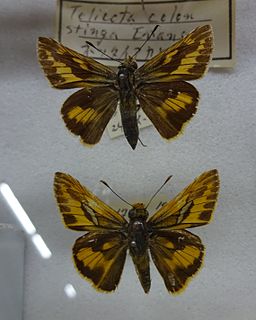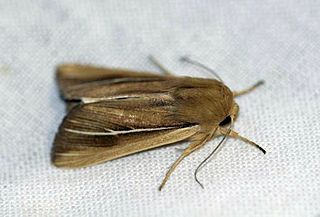
The grove snail or brown-lipped snail is a species of air-breathing land snail, a terrestrial pulmonate gastropod mollusc. It is one of the most common species of land snail in Europe, and has been introduced to North America.

The garden dart is a moth of the family Noctuidae. It is distributed throughout much of the Palearctic. Temperate regions of Europe, Central Asia and North Asia, as well as the mountains of North Africa. Absent from polar regions, on Iceland and some Mediterranean islands, as well as in Macaronesia.

Agrotis segetum, sometimes known as the turnip moth, is a moth of the family Noctuidae. The species was first described by Michael Denis and Ignaz Schiffermüller in 1775. It is a common European species and it is found in Africa and across Eurasia except for the northernmost parts.

The heart and dart is a moth of the family Noctuidae. The species was first described by Carl Linnaeus in his 1758 10th edition of Systema Naturae. A familiar moth to many, it is considered one of the most common of the European region. It occurs throughout the Palearctic ecozone from Ireland to Japan.

The small angle shades is a moth of the family Noctuidae. It is distributed throughout the Palearctic. The species was first described by Carl Linnaeus in his 1758 10th edition of Systema Naturae.

Apamea monoglypha, the dark arches, is a moth of the family Noctuidae. The species was first described by Johann Siegfried Hufnagel in 1766. It is a common, sometimes abundant, European species. It is found in most of Europe except northernmost Fennoscandia and the southern parts of the Iberian Peninsula and Greece. The species is also found in Anatolia, Turkestan, Western Asia and Central Asia, Siberia and Mongolia. In the Alps it is found up to heights of 2,500 meters. The smaller subspecies sardoa is found on Sardinia and Corsica.

Apamea crenata, known as the clouded-bordered brindle, is a moth in the Noctuidae family. It is distributed throughout the Palearctic ecozone.

Telicota colon, commonly known as the pale palm dart or common palm dart, is a butterfly belonging to the family Hesperiidae found in India to Australia.

Agrotis is a genus of moths of the family Noctuidae. The genus was erected by Ferdinand Ochsenheimer in 1816. A number of the species of this genus are extinct.

Agrotis ipsilon, the dark sword-grass, black cutworm, greasy cutworm, floodplain cutworm or ipsilon dart, is a small noctuid moth found worldwide. The moth gets its scientific name from black markings on its forewings shaped like the letter "Y" or the Greek letter upsilon. The larvae are known as "cutworms" because they cut plants and other crops. The larvae are serious agricultural pests and feed on nearly all varieties of vegetables and many important grains.

Murlough Nature Reserve lies on the coast of County Down in Northern Ireland, situated close to Newcastle. It has views of Slieve Donard, the highest peak in the Mourne Mountains and Dundrum Bay. Its 6,000-year-old sand dune system has been managed by the National Trust since 1967, when it became Ireland's first nature reserve. Grid ref: J414351.

Euxoa obelisca, the square-spot dart, is a moth of the family Noctuidae. It is found in the Palearctic ecozone.

Mythimna litoralis, the shore wainscot, is a moth of the family Noctuidae.

Mesapamea secalis, the common rustic, is a moth of the family Noctuidae. The species was first described by Carl Linnaeus in his 1758 10th edition of Systema Naturae. It is found in Europe, north-west Africa, Turkey and northern Iran.

Agrotis ripae, the sand dart, is a moth of the family Noctuidae. The species was first described by Jacob Hübner in 1823. It is found in western Europe and North Africa and extends east across the Palearctic to steppe areas in Russia, Mongolia and Siberia.

Agrotis vestigialis, the archer's dart, is a moth of the family Noctuidae. The species was first described by Johann Siegfried Hufnagel in 1766. It is found in most of the Palearctic ecozone from Ireland east, through to Russia, Siberia, the Altai mountains and the Amur region, and is also present in the Mediterranean area. It is absent from the north of Finland and Norway.

Apamea scolopacina, the slender brindle, is a moth of the family Noctuidae. The species was first described by Eugenius Johann Christoph Esper in 1788. It is found across the Palearctic ecozone from central Europe to the Kuril Islands northeast of Japan.

Agrotis trux, the crescent dart, is a moth of the family Noctuidae. The species was first described by Jacob Hübner in 1824. It has a circum-Mediterranean distribution and is found along the coasts of France, Ireland, England, southern Europe, Algeria, Syria, Iraq, Iran, southern Russia and the Arabian Peninsula. In Africa, it is found as far south as South Africa.

Sphingomorpha chlorea, the sundowner moth, is a species of moth in the family Erebidae that is native to Africa and southern Asia. The species was first described by Pieter Cramer in 1777. It is a fruit-piercing moth and a notorious pest in orchards. The fruit is pierced while performing a vertical and rhythmic movement of the head.


















